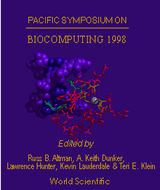Reveal, a general reverse engineering algorithm for inference of genetic network architectures
Liang S, Fuhrman S, Somogyi R
SETI Institute, NASA Ames Research Center, Moffett Field, CA 94035, USA. sliang@mail.arc.nasa.gov
Pac Symp Biocomput. 1998;:18-29.

Abstract
Given the immanent gene expression mapping covering whole genomes during development, health and disease, we seek computational methods to maximize functional inference from such large data sets. Is it possible, in principle, to completely infer a complex regulatory network architecture from input/output patterns of its variables? We investigated this possibility using binary models of genetic networks. Trajectories, or state transition tables of Boolean nets, resemble time series of gene expression. By systematically analyzing the mutual information between input states and output states, one is able to infer the sets of input elements controlling each element or gene in the network. This process is unequivocal and exact for complete state transition tables. We implemented this REVerse Engineering ALgorithm (REVEAL) in a C program, and found the problem to be tractable within the conditions tested so far. For n = 50 (elements) and k = 3 (inputs per element), the analysis of incomplete state transition tables (100 state transition pairs out of a possible 10(15)) reliably produced the original rule and wiring sets. While this study is limited to synchronous Boolean networks, the algorithm is generalizable to include multi-state models, essentially allowing direct application to realistic biological data sets. The ability to adequately solve the inverse problem may enable in-depth analysis of complex dynamic systems in biology and other fields.
[Full-Text PDF] [PSB Home Page]